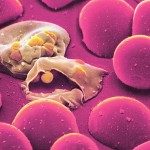Link to Pubmed [PMID] – 24617597
Cell. Microbiol. 2014 May;16(5):768-83
Calcium is a key signalling molecule in apicomplexan parasites and plays an important role in diverse processes including gliding motility. Gliding is essential for the malaria parasite to migrate from the skin to the liver as well as to invade host tissues and cells. Here we investigated the dynamics of intracellular Ca(2+) in the motility of Plasmodium berghei sporozoites by live imaging and flow cytometry. We found that cytosolic levels of Ca(2+) increase when sporozoites are activated in suspension, which is sufficient to induce the secretion of integrin-like adhesins that are essential for gliding motility. By increasing intracellular Ca(2+) levels artificially with an ionophore, these adhesins are secreted onto the sporozoite surface, however, the parasite is not capable of gliding. A second level of Ca(2+) modulation was observed during attachment to and detachment from a solid substrate, leading to a further increase or a decrease in the cytoplasmic levels of Ca(2+) respectively. We also observed oscillations in the intracellular Ca(2+) level during gliding. Finally, an intracellular Ca(2+) chelator, an inhibitor of phosphoinositide-specific phospholipase C (PI-PLC), and an inhibitor of the inositol triphosphate (IP3) receptor blocked the rise in intracellular Ca(2+) , adhesin secretion, and motility of activated sporozoites, indicating that intracellular stores supply Ca(2+) during sporozoite gliding. Our study indicates that a rise in intracellular Ca(2+) is necessary but not sufficient to activate gliding, that Ca(2+) levels are modulated in several ways during motility, and that a PI-PLC/IP3 pathway regulates Ca(2+) release during the process of sporozoite locomotion.
